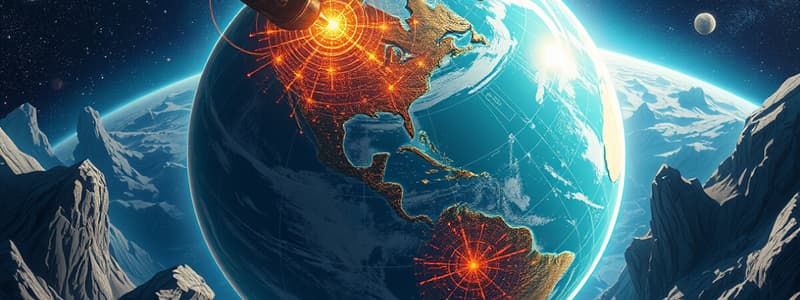Podcast
Questions and Answers
What is geodesy?
What is geodesy?
Geodesy is the scientific discipline that deals with the measurement and understanding of Earth's shape, orientation, gravity field, and their variations over time.
Which of the following are the three main pillars of geodesy? (Select all that apply)
Which of the following are the three main pillars of geodesy? (Select all that apply)
- Gravity Field (correct)
- Earth Rotation and Orientation (correct)
- Satellite Data
- Geokinematics (correct)
What is one application of geodesy?
What is one application of geodesy?
- Software Development
- Fashion Design
- Mapping (correct)
- Cooking
Geodesy studies Earth's ____, including its strength and variations in space and time.
Geodesy studies Earth's ____, including its strength and variations in space and time.
What does satellite geodesy focus on?
What does satellite geodesy focus on?
The first artificial satellite launched was Sputnik 2.
The first artificial satellite launched was Sputnik 2.
What major satellite system was developed in the 1970s?
What major satellite system was developed in the 1970s?
Geodetic surveying involves the collection of precise measurements on the Earth's surface to establish ____ networks.
Geodetic surveying involves the collection of precise measurements on the Earth's surface to establish ____ networks.
What does geodetic geophysics study?
What does geodetic geophysics study?
Which technique is NOT mentioned as one of the geodetic measurement methods?
Which technique is NOT mentioned as one of the geodetic measurement methods?
Match the following branches of geodesy with their focus:
Match the following branches of geodesy with their focus:
The curved path taken by an object moving around another body in space is called an orbit.
The curved path taken by an object moving around another body in space is called an orbit.
Flashcards are hidden until you start studying
Study Notes
Basics of Geodesy
- Geodesy measures Earth's geometric shape, orientation, and gravity field.
- The three main pillars include Geokinematics, Earth Rotation and Orientation, and Gravity Field.
- Reference Frames unify these pillars, facilitating accurate measurements.
Importance of Geodesy
- Forms the foundation for accurate mapping and cartography.
- Essential for navigation systems like GPS and GNSS, enabling precise positioning.
- Provides critical data for Earth sciences, including tectonic movements and sea-level changes.
- Important for infrastructure development, ensuring accurate positioning for construction and urban planning.
- Contributes to climate studies by monitoring changes in sea levels and land movements.
Branches of Geodesy
- Geodetic Surveying: Collects precise measurements on Earth's surface using techniques like triangulation and GPS.
- Physical Geodesy: Studies Earth's gravity field and mass distribution to understand geodynamic processes.
- Satellite Geodesy: Utilizes satellite data for precise positioning, gravity field studies, and deformation monitoring.
- Geodetic Datum and Reference Frames: Establishes coordinate systems for consistency in geodetic data.
- Geodetic Geophysics: Combines geodetic techniques with geophysical principles to study Earth’s interior.
- Geodetic Geodynamics: Monitors Earth's dynamic processes, including plate tectonics, using various geodetic measurements.
Introduction to Satellite Geodesy
- Satellite geodesy uses artificial satellites to measure Earth's shape, orientation, and gravity field.
- It plays a crucial role in positioning, height determination, and monitoring Earth’s deformation.
Historical Overview of Space Geodesy
- Geodesy’s roots trace back to ancient civilizations with early measurement attempts.
- The launch of Sputnik 1 in 1957 marked the beginning of satellite geodesy.
- The Transit satellite system (1960) allowed for accurate positioning; GPS was developed in the 1970s.
Basic Geodetic Problems
- Determining three-dimensional positions for geodetic control.
- Studying gravity variations to determine the geoid and equipotential surfaces.
- Analyzing satellite orbits for identifying external equipotential surfaces.
- Modeling geodynamical phenomena like polar motion and crustal deformation.
Measurements in Geodesy
- Astronomic Measurements: Involves position and azimuth determinations.
- Gravity Measurements: Includes both absolute and relative gravity measurements.
- Terrestrial Geodetic Measurements: Horizontal angles, distances, and zenith angles are key techniques.
- Satellite Observations: Involves both unperturbed and perturbed motions of satellites for precise techniques like GPS and Doppler shifts.
Satellite Geodesy Applications
- Allows seamless navigation and surveying over diverse terrains.
- Necessary for determining the actual shape of the Earth.
- Enables remote monitoring of tectonic movements.
Two-body Problem
- Focuses on the motion of two point particles interacting through gravity.
- Kepler’s laws describe orbital motion, influencing satellite trajectories.
Keplerian Laws of Planetary Motion
- Orbits of planets are elliptical with the Sun at one focus.
- Equal areas are swept out in equal time intervals by planet-Sun lines.
- The ratio of the squares of orbital periods of planets relates to the cubes of their average distances from the Sun.
Key Components of Satellite Orbit
- Keplerian Elements: Include semi-major axis, inclination, eccentricity, and time of perigee pass.
- Forces Acting on Satellites: Include Earth's gravity, lunar and solar gravitational attraction, radiation pressure, and relativistic effects.
Space Geodetic Networks
- Various networks (GNSS, SLR, VLBI, DORIS) support the development of the Terrestrial Reference Frame (TRF) for accurate measurements.
- Data from space geodetic measurements aid in understanding geophysical phenomena and provide vital information for satellite missions and atmospheric measurements.
Studying That Suits You
Use AI to generate personalized quizzes and flashcards to suit your learning preferences.




